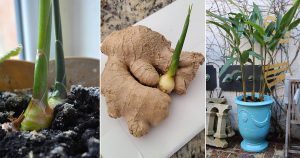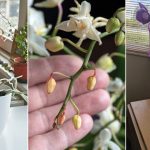What is Chervil? If you have this question in your mind then this article will tell you Everything About Growing Chervil in detail!
Chervil or Anthriscus cerefolium is a delicious annual herb that never fails to make a solid impression in kitchen gardens and outdoors with its lush green look. The unique, sweet, peppery flavor of this herb makes it a favorite plant for growing at home. It loves to grow in cool, shady spots.
Common Names: French Parsley or Garden Chervil
What is Chervil?
Chervil is a tender, leafy herb that usually grows 12-24 inches tall. Once matured, this plant produces tall flower stalks with clusters of tiny, edible, white blooms. This highly aromatic herb with underlying notes of anise provides delicate, sweet flavor that can taste like a combination of fennel, licorice, and parsley. However, the herb tastes bitter when the plant starts to flower.
Popular as Rich Man’s Parsley, French parsley, or sweet cicely, this annual herb grows best in USDA Zones 3-7. It is majorly used in French cuisine, along with chives, tarragon, and parsley.
Propagating Chervil

Chervil can be propagated by seeds, cuttings, and division. The best way to propagate chervil is through seeds. Check the details below.
From Seeds: This cool-season plant will self-seed and can be propagated from seeds at different times of the year as per the local climate. If you plan to grow chervil in cool climates, sow the seeds simultaneously every three to four weeks from early spring to mid-summer and once again in fall. In hot weather, sow the seeds when the daytime temperature drops below 65 F.
From Division: You can divide the plant in spring and plant it in well-draining soil. Make sure the division has sufficient roots and shoots.
Requirements for Growing Chervil

Location
Choose a place that receives partial shade for the chervil to thrive best. Chervil tends to bolt faster in warmer weather and shoots up white blooms that turn into seed heads and dull the flavor.
Avoid any location that receives full and direct sunlight to preserve the delicious taste.
Soil
Chervil loves to grow in fertile, humus-rich, damp, loamy soil with a pH between 6.5 and 7.0. To encourage the nutrients, you can prepare the best soil for this herb by mixing a good amount of organic content, such as compost.
Watering
Keep this plant well-watered, as the medium needs to be evenly moist. It does not prefer dry conditions, so do not wait for the top layer to dry out.
If the top 0.5 inch starts to feel dry, it is time to water it. On average, it requires about an inch of water every week. Avoid wetting the delicate leaves.
Also, Potted-chervil plants need regular watering. Reduce watering in the cool season and winter months.
Temperature
Chervil can thrive well in partial shade and partial sunlight in cooler parts. It is ideal when the temperature remains above freezing and below 65°F or 18°C during the growing period.
If you live in a hot climate and grow chervil, plant it in full shade or move pots indoors where temperatures are above 80°F or 26°C.
Chervil Care
Fertilizer
You may not need additional fertilizing if you have added enough organic matter for this short-lived plant during planting. However, if needed, you can feed it with a balanced nitrogen-rich fertilizer once or twice during the growing season.
Do refer to the label for dosage and instructions.
Pruning
Maintain the shape of the plant with frequent harvesting. Prune the flower buds whenever you notice them. Use clean pruning shears for harvesting and promote new growth.
Pests and Diseases
Chervil can be a big target for slugs and aphids. Try picking any slugs off using your hand to keep these bugs at bay. You can plant some companion plants nearby, such as lettuce, Brassicas, and radishes, to ensure it stays safe from these pests.
In diseases, the most common disease affecting chervil is downy mildew, caused by the fungus-like organism Plasmopara. This disease manifests as pale yellow patches on the upper leaf surface, with a fluffy, white to pale gray fungal growth on the underside.
Another concern is the Cercospora leaf spot, which presents small, dark spots on the leaves. This fungal disease can spread in wet conditions.
Additionally, chervil might fall prey to root rot in waterlogged soils, leading to the wilting and yellowing of plants.
To combat these diseases, ensure good airflow around the plants, avoid overhead watering, and practice crop rotation. Using disease-free seeds and ensuring well-draining soil can also help prevent these ailments.
Harvesting Chervil

Chervil can be harvested after 6-8 weeks after sowing. Pick the fresh leaves in the morning using clean and sharp scissors, or snip leaves from your hands.
You can store the chervil in the refrigerator for a few days by wrapping it in kitchen paper.
Growing Chervil as a Microgreen
You can also choose to grow this gourmet herb as a microgreen. Take a shallow plastic tray, fill it with soilless seed mix, and spread the seeds on top. Use 1-2 teaspoons of chervil seeds for every 6-9 inches long and 3-6 inches wide tray and gently press them in.
Use a spray bottle to moisten the medium and place it in a clear plastic bag. Place a few sticks to keep the plastic from touching the growing medium and poke in 10-15 holes for ventilation. Once the seeds germinate, remove the plastic cover and place it in a bright spot where it receives 4-5 hours of morning sunlight daily.
When the sprouts grow up to 5-6 inches tall, you can harvest the microgreens, snipping them off down to the soil line.










